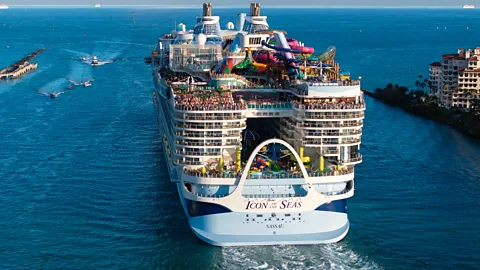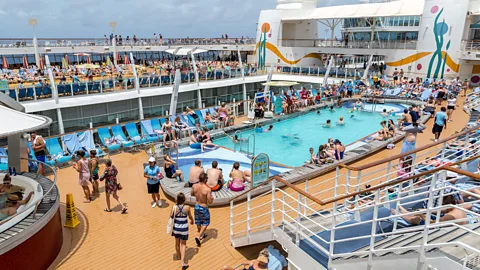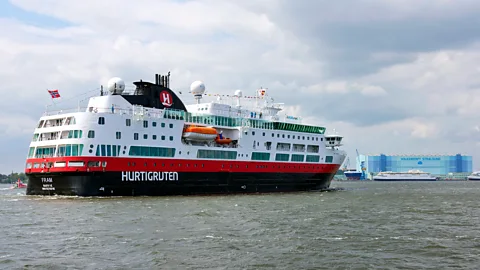Are 'green' cruise ships good for the climate?
 Getty Images
Getty ImagesMany cruise companies are touting their green credentials. But can cruise ships ever be sustainable?
In January, the world's largest cruise ship set sail on its seven-day maiden voyage from the Port of Miami. The vessel, named Icon of the Seas, cost Royal Caribbean $2bn (£1.6bn) to build, has 18 decks, seven swimming pools and more than 40 restaurants, bars and lounges. It is 365m (1,195ft) long – 35m (115ft) longer than the Eiffel Tower and about five times as large as the Titanic.
The ship is powered by liquified natural gas (LNG) which Royal Caribbean has described as the "cleanest-burning marine fuel available". But environmental campaigners say LNG harms the climate because it leaks polluting methane into the atmosphere, which is about 80 times more potent than carbon dioxide (CO2) over a 20-year time span.
The industry's impact on the natural world is only set to grow as cruising booms. Ticket sales for cruise ships in 2024 have reached an all-time high. By the end of the year, 360 cruise ships are projected to have carried a total of 30 million passengers, a 9.2% increase compared to 2019, before Covid-19 hit.
"The problem is that the number of cruise ships keeps growing and the size of those cruise ships keeps growing as well," says Constance Dijkstra, shipping campaigner at the non-profit Transport & Environment. This will lead to more air and ocean pollution, she adds.
Many cruise companies have started touting their green credentials. But Dijkstra and other campaigners say that few are reducing their environmental footprint fast enough.
Cruise contamination
A large cruise ship can use up to 80,645 gallons (304,593 litres) of marine fuel per day, according to analysis by the University of Colorado Boulder. Marine fuels are variants of emissions-producing fossil fuels and therefore have a high carbon footprint.
Cruises are also a particularly carbon-intensive way to travel compared with many other types of holiday. The average CO2 emissions of a passenger on a cruise around Seattle are eight times higher than those of a tourist spending their holiday on land in Seattle, an analysis by the non-profit Friends of the Earth concluded.
And it's not just atmosphere-warming CO2 that's the problem. The 218 cruise ships operating in Europe in 2022 emitted more sulphur oxides (SOx) than one billion cars, or 4.4 times more than all the continent's cars, according to additional analysis by the non-profit Transport & Environment. SOx can harm trees by decreasing growth and contribute to acid rain which can damage sensitive ecosystems. Exposure to the pollutant can also harm the human respiratory system and cause breathing problems.
"We continue to caution people: 'If you're concerned about the environment, perhaps think about another kind of vacation,'" says Marcie Keever, director of the oceans and vessels programme at Friends of the Earth.
 Getty Images
Getty ImagesBut is cruising worse than flying?
Even the most efficient cruise ships emit more CO2 per passenger kilometre than a passenger jet, according to analysis by the International Council on Clean Transportation (ICCT), a US-based non-profit.
Waste is another major problem. More than 31bn litres (8.5bn gallons) of toxic waste were discharged off the west coast of Canada by cruise ships travelling to and from Alaska in 2019.
Plus, noise pollution from ships harms marine life. A 2012 study found that mid-range noise from ships' sonar overlaps with blue whales' calls to each other, forcing them to repeat their vocalisations and disrupting their communication. (Read more about the surprisingly simple solutions to protect ocean life from man-made noise.)
Cleaning up cruising
Port cities are starting to crack down on cruise ships amid mounting health and environmental concerns. In 2021, Venice banned cruise ships from entering its historic centre, restricting them to the industrial port in response to a request from UN cultural body Unesco due to cruise pollution damaging historic buildings. Amsterdam and Barcelona have also banned cruise ships from their centres, in a bid to curb pollution and reduce overtourism.
"This is an industry that's flown under the radar when it comes to regulation," says Keever. "We're now seeing communities stand up to cruise ships and say 'the environmental pollution and the amount of passengers you're bringing here is too much.'"
More like this:
Cruise companies have started introducing measures to improve their sustainability record, such as switching to more energy-efficient appliances and engines, connecting to shore power while in port, running recycling schemes and reducing single-use plastic on board.
But it's the need to switch away from polluting fossil fuels that arguably poses the industry's largest challenge.
"To have a green cruise implies a change of fuel, which is very difficult," says Dijkstra. "It's great that cruise ships are promoting recycling or going plastic free, but if they're going to keep using fossil fuels, we're in trouble."
 Getty Images
Getty ImagesMany cruise companies have started running their ships on LNG, promoting it as the cleanest, at-scale alternative to polluting marine diesel. Between 2023 and 2028, 60% of new ships due to set sail will rely on LNG fuel for their primary propulsion, according to the Cruise Line International Association.
Carnival Corporation, one of the world's largest cruise operators, is relying on LNG to reduce its carbon footprint. The company aims to reduce its carbon intensity – the quanity of CO2 emitted per nautical mile – by 20% by 2030, compared to 2019 levels. It currently has nine LNG ships in operation, with orders placed for four more.
"There's a limit to how far we can go with efficiency measures," Vice Admiral Bill Burke, chief maritime officer at Carnival Corporation, tells the BBC. "We're probably in a situation where we're only going to get 20-30% of our overall emissions reduction [through efficiency measures].
"Ultimately, we need new fuels and right now the best fuel out there, that is readily available, is LNG."
But others disagree that LNG is the solution to cruise ships' climate problem. "LNG is not a transition fuel," says Keever. "It shouldn't even be part of the conversation."
While LNG ships emit about 25% less CO2 than conventional marine fuels, they have an additional harmful impact on the climate as they release methane, campaigners say. "Methane has a disastrous impact in terms of global warming," says Dijkstra. The greenhouse gas breaks down in the atmosphere in just 12 years, which is much faster than the centuries taken by CO2 – but methane is also about 80 times more powerful over a 20-year time span.
According to analysis by Transport & Environment, one of the UK's first LNG-powered cruise ships, P&O's Iona, emitted as much methane in 2022 as 10,500 cows over a year. A spokesperson for P&O told the BBC at the time that "LNG has much lower overall greenhouse gas emissions vs conventional fuels, even factoring in methane slip."
"Even with methane slip, the greenhouse gas footprint of LNG is better than marine fuel oil," says Burke. "It's the best fuel out there today."
Transport & Environment notes that no one knows the true extent of the methane emissions from LNG-powered ships, as the data is not available.
The race to replace gas
Whether or not LNG is an improvement on marine diesel, ultimately sustainable fuels that emit little to no greenhouse gases are needed to decarbonise shipping and meet the industry's 2050 net-zero goal, experts say. But which fuel can do this at scale remains up for debate.
Across the wider sector, companies are investing in hydrogen, methanol and ammonia as the shipping fuels of the future.
Container giant Maersk is relying on methanol to reach its 2040 net-zero target. Methanol can be a low-carbon fuel when produced from sustainable biomass or using renewable electricity to split water into oxygen and hydrogen, then combining it with CO2 to form methanol. It can cut CO2 emissions by up to 95% and nitrogen oxide emissions by up to 80%, according to the Methanol Institute, an industry body. Some argue that green methanol is not the right fuel to decarbonise shipping, however, as production is energy intensive and still results in CO2 emissions.
Another alternative is green ammonia, made by electrolysing water with renewable electricity. Analysis by the Environmental Change Institute at the University of Oxford found that green ammonia, which emits no CO2 when burned but does produce nitrous oxide emissions, could decarbonise 60% of global shipping when provided at just the top 10 regional fuel ports.
 Getty Images
Getty ImagesBut the Cruise Lines International Association (CLIA), the trade body for the cruise industry, says that alternative fuels such as methanol and ammonia are not viable options.
"There are currently no sustainable alternative fuels available at scale to achieve [the cruise industry's] decarbonisation ambitions," says Andy Harmer, managing director of CLIA UK and Ireland. "CLIA is calling on governments to help accelerate the transition by setting more ambitious production targets, particularly for synthetic and biofuels."
Burke says that while methanol is the fuel that people often talk about, it's more expensive [than LNG and marine fuel] and not readily available. "There is no green methanol today," he adds, noting that most methanol is currently produced using natural gas, rather than renewable energy.
The process to produce green methanol is complex: CO2 must be captured out of the atmosphere, via technology which is still emerging, expensive and as yet unproven at scale.
However, the other green fuels on offer also spark other concerns. Ammonia is a highly toxic, corrosive and flammable fuel, according to the Global Maritime Forum, a non-profit based in Denmark. "Ammonia is toxic," Burke says. "It's not the best fuel for cruises – we've got 8,000 people on our ships, and many in our engine rooms."
Dijkstra says many cruise companies say ammonia is unsafe to use on board ships carrying passengers. "But other companies are looking at that option…we are, for example, seeing DFDs ferries betting on ammonia," she says.
Keever says "it is feasible" for cruise ships to wean themselves off polluting fuels and switch to greener alternatives produced using renewable energy, such as methanol and ammonia, rather than fossil fuels.
"It's already happening in the larger shipping industry," says Keever, adding that Maersk, for example, is investing heavily in methanol. Transitioning to greener fuels "takes time and effort and a willingness to turn away from our dependence on fossil fuels," she adds.
Battery power
Norwegian cruise company Hurtigruten is focusing on a different technology to power its ships: batteries.
The cruise line company Hurtigruten aims to launch a zero-emissions cruise ship by 2030, which will be powered by 60MW batteries and huge, retractable solar sails, as part of its "sea zero" initiative (Read more: Will shipping return to its ancient roots?).
"We are using advanced battery and solar technology alongside old-fashioned tech: sails," says Hedda Felin, the company's chief executive. "We have sun 24 hours a day in the summer in Norway and it's very windy on the coast, so the ship is really tailored for the Norwegian coastline."
 Getty Images
Getty ImagesFour of Hurtigruten's fleet of nine cruise ships already have hybrid engines, which can run on both diesel and batteries.
"Hurtigruten are one of the leaders in the industry when it comes to adopting cleaner technologies, including [greener] fuels and advanced sewage treatment systems," says Keever. "And this is important because they go to places like the Arctic."
But there are limits to the distances batteries can power. The technology works well for Hurtigruten coastal cruises as "we are never more than six hours away from a port", says Felin. But it is not a practical solution for ocean cruise liners. "If we were crossing the Atlantic, batteries would definitely not be considered," says Felin.
Cruise companies visiting climate vulnerable locations, such as the Arctic, and bringing thousands of tourists to remote communities have a responsibility to operate more sustainably, says Felin.
"The cruise industry needs to take more responsibility…We are lagging behind massively," she says, adding that cruise companies have been slow to transition to cleaner alternatives.
But Felin says there is hope on the horizon; new technology and fuels will help power a more sustainable future for cruise ships. "There are several proven and safe choices for the future which mean we do not need to have fossil fuels on our cruise ships," she says. "That is the hope for the entire cruise industry."
The Royal Caribbean did not respond to the BBC's request for comment.
--
For essential climate news and hopeful developments to your inbox, sign up to the Future Earth newsletter, while The Essential List delivers a handpicked selection of features and insights twice a week.
